Spanish-style bullfighting
Spanish-style bullfighting is a type of bullfighting that is practiced in Spain, Mexico, Colombia, Ecuador, Venezuela, Peru, as well as in parts of southern France and Portugal. This style of bullfighting involves a physical contest with humans (and other animals) attempting to publicly subdue, immobilize, or kill a bull. The most common bull used is the Spanish Fighting Bull (Toro Bravo), a type of cattle native to the Iberian Peninsula. This style of bullfighting is seen to be both a sport and performance art. The red colour of the cape is a matter of tradition – bulls are color blind. They attack moving objects; the brightly-colored cape is used to mask blood stains.
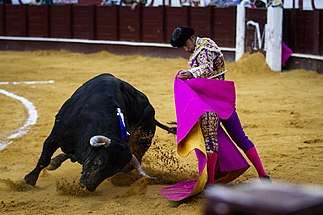
In a traditional corrida, three toreros (or matadores) each fight against two out of a total of six fighting bulls to death, each bull being at least four years old and weighs up to about 600 kg (1,300 lb) (with a minimum weight limit of 460 kg (1,010 lb)). Bullfighting season in Spain runs from March to October. The practice is also known as a corrida de toros ("bull-running"), tauromaquia, or fiesta. Since the late-1980s, bullfighting in Spain has declined in popularity due to animal welfare concerns, its association with blood sport, and its links to nationalism.
History
.jpg)
Pre-Roman
Most historians trace festivities involving bulls to prehistorical times, as a trend that once extended through the entire Mediterranean coast and has just survived in Iberia and part of France.[1] Early bullfights had a high mortality rate.[1] Alejandro Recio, a Spanish historian, considers the Neolithic city of Konya, Turkey, discovered by James Mellaart in 1958, as evidence of sacrificial tauromaquia associated with traditional rituals.[2] This claim is based on the abundance of representations of bulls, as well as on the preservation of horns and bullheads attached to walls.[1] Since then various archeological findings have proven the uninterrupted importance of the bull as a symbol of the sun for the Iberian cults, like the presence of berracos (known in Portuguese as berrão), or the importance of the bull in the surviving Celtiberian and Celtic rituals that continued into the 21st century.[1] These pre-roman religions centered on the ritual sacrifice of sacred animals through direct or symbolic combat and was a likely motive for the depiction of bulls.[3]
Roman
Bullrings are believed to originate their bullfighting tradition from Roman gladiator games.[4] During Roman Hispania gladiators were forced to fight by sword bulls, bears, and wolves.[5] The Romans tried to abolish and ban the "puere" practice of bullfighting, considering it was too risky for the youth and not a proper way to worship the state deities.[5]
Arab prohibition
During the Arab rule of Iberia, the ruling class tried to ban the practice of bullfighting, considering it a pagan celebration and heresy.[6] Bullfighting was illegal in all Arab territory but became a mark of identity and resistance for Christian Iberians, especially for the nobility that started using it as a way to gain prestige. At first, bullfighting was done on horseback and was reserved for Spanish aristocracy; in contests the fighters were referred to as rejoneadors.[1]
Catholic excommunication
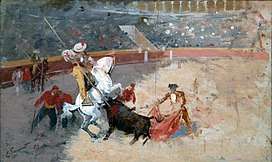
In the 16th century Pope Pius V banned bullfighting for its ties to paganism and for the danger it posed to the participants.[7] Anyone who would sponsor, watch or participate in a bullfight was to be excommunicated by the Church.[7] Spanish and Portuguese bullfighters kept the tradition alive covertly, and his successor, Pope Gregory XIII, took efforts to relax this penalty.[8] Pope Gregory advised bullfighters to not use the sport as way to honor Jesus Christ or the Saints, as was typical in Spain and Portugal.[7]
The Bourbons
King Philip V, the first King of Spain of Bourbon descent, ended bullfighting in the country because he believed it was in poor taste for nobles to practice such a bloody sport.[9] The change in bullfighting standards ran parallel to the discontent of the foreign rule of the Bourbons, and their lack of interest in understanding the politics, economics or culture of their new kingdom culminated in the Esquilache Riots of 1766.[10] New forms of bullfighting continued to develop despite anti-French and anti-nobility sentiments.[10] After growing in popularity in Spain, King Carlos III attempted to ban bullfighting in 1771.[11] He attempted to reduce the social tension by building two of the eldest and largest bullfighting rings in Madrid as part of an offensive to fix the hostility and alienation that the Spanish felt towards the French rulers.[11] King Charles IV attempted to formally ban the sport again after his predecessor made concessions.[11] King Joseph Bonaparte reversed this decision by hosting a bullfight during his coronation in 1808.[11]
Joaquín Rodríguez Costillares
Joaquín Rodríguez Costillares (1743–1800) was a Spanish bullfighter from Seville who has been credited with founding modern Spanish-style bullfighting.[12][13] He established the "cuadrillas tradition" where teams of two or three banderilleros and two picadors taunt the bull.[14] He also organized the tercios de lidia ("thirds of fight") borrowed from the theatre; invented the Veronica and other basic cape movements as well as the current traje de luces ("suit of light"); and created the cape maneuvers (muleta), typical in this style of bullfighting since the 19th century.[15]
Participants
Each matador has six assistants—two picadores ("lancers") mounted on horseback, three banderilleros ("flagmen"), and a mozo de espada ("the lad of the swords"). Collectively they compose a cuadrilla or team of bullfighters. The crew also includes an ayuda (aide to sword servant) and subalternos (subordinates) including at least two peones (pages, singular peón).[16][17]
Parts of a bullfight

The modern Spanish-style bullfight (corrida) is highly standardized, with three distinct parts (or tercios), the start of each of which is announced by a trumpet sound.[18] The participants first enter the arena in a parade (paseíllo) to salute the presiding dignitary (presidente), usually accompanied by band music.[18] The corrida begins to the tune of live-played pasodobles, many of which were composed to honour famous toreros.[18] Torero costumes are influenced by 17th century Andalusian clothing.[19] Matadors are distinguished by a "suit of lights" (traje de luces), custom-made and embroidered with silver or golden thread.[20]
The bull then enters the ring to be tested for aggressiveness by the matador and banderilleros with the magenta and gold capote (dress cape).[21] Bulls are raised on the open range by specialist breeding estates called ganadería. The bull enters the arena with a rosette on its back bearing the colours of the estate of its origin.[22]
Stage 1: Tercio de Varas
The first stage is called the tercio de varas ("part of lances").[23] The matador observes how the bull reacts to the waving of the banderilleros' cloak. They also note vision problems, unusual head movements, or if the bull favors a part of the ring called a querencia (territory).[21] A bull trying to reach its querencia is often more dangerous than a bull that is attacking the cape directly.[21] The initial attack by the matador is called the suerte de capote ("act of the cape"), and there are a number of fundamental "lances" (or passes) that matadors make; the most common being the verónica (named after Saint Veronica), which is the act of a matador letting their cloak trail over the bull's head as it runs past.[24]
Then two picadores enter the arena each armed with a lance (vara), mounted on large heavily-padded and blindfolded horses.[25] The entrance of the house attracts the bull to the picadores.[21] The picador stabs a mound of muscle (morrillo) on the bull's neck, drawing blood and animating the animal.[26] As the picador stabs at the bull's neck, the bull charges and attempts to lift the picador's horse.[27] If the picador is successful, the bull will hold its head and horns lower in a show of aggression during the following stages of the fight.[28] This makes the bull less dangerous while enabling the matador to perform the passes of modern bullfighting.[21] In a mandatory step in the corrida, regulations require that a plaza judge ensures a certain number of hits are made before it is considered completed.
Stage 2: Tercio de Banderillas
In the next stage – the tercio de banderillas ("part of small flag") – the matador attempts to plant two barbed or dart-like sticks known as banderillas ("little flags") onto the bull's shoulders.[29] These weaken the ridges of neck and shoulder muscle (which set fighting bulls apart from cattle) through loss of blood, while also spurring the bull into making more aggressive charges. By this point the bull has lost a significant amount of blood, exhausting the animal. The matador then enters with his cape and sword,[29] attempting to tire the bull further with several runs at the cape.

The matadors place the banderillas around the bull. If the presidente decides that the bull is relatively weak or unwilling to fight, they may order the use of black banderillas, considered to be a poor reflection on the breeder.[30]
Stage 3: Tercio de Muerte
In the third and final stage – the tercio de muerte ("part of death") – the matador re-enters the ring alone with a small red cape or muleta in one hand and a sword (estoc) in the other.[21] This cape is stretched with a wooden dowel and, in right-handed passes, the sword as well.[21] Having dedicated the bull to an individual or the whole audience, the matador uses his cape to attract the bull in a series of passes, demonstrating their control over it.[21] The red colour of the cape is a matter of tradition – bulls are color blind.[31] As bulls attack moving objects; colored capes are used to mask blood stains.[31]
The faena is the entire performance combined with the muleta, which is usually broken down into a series of tandas (episodes). A typical tanda consists of three to five basic passes and then the finishing touch (remate), such as a pase de pecho, or pase de desprecio. Well-received passes are celebrated by the audience with shouts of "¡ole!". The faena ends with a final series of passes in which the matador with a muleta attempts to manoeuvre the bull into a position to stab it between the shoulder blades and through the aorta or heart. The entire part of the bullfight with the muleta is called the tercio de muerte ("third of death") or suerte de muleta ("act of muleta").[32][33]
The act of thrusting the sword (estoca or estoque) is called an estocada.[21] A clumsy estocada that fails to give a "quick and clean death" will often raise loud protests from the crowd and may ruin the whole performance. If estocada is not successful, the matador must then perform a descabello and cut the bull's spinal cord with a second sword called verdugo, to kill it instantly and spare the animal pain.[21] Although the matador's final blow is usually fatal, it may take the bull some time to die. A coup de grâce is therefore administered by a peón named a puntillero, using a dagger to further pierce the spinal cord. The matador must kill the bull in 15 minutes after the first muleta pass, at most. After 10 minutes, if the bull is still alive, the presidente will order an aviso, a warning given with a trumpet sound. If a further three minutes elapse, a second aviso will be given; a third and final aviso is given after a further two minutes. The presidente will then give an order to have the bull returned to its pen (corral), or, if local law so requires, to have the bull killed outside the ring. It is a dishonor for the failing matador.
The bull's body is dragged out by a team of mules. If the presidente is impressed by the performance of the bull, he orders a tour around the ring to honour the animal. Very rarely, a bull will be allowed to survive a fight as an indulgence granted in recognition of an exceptional performance. The spectators will demand an indulto from the presidente, by waving handkerchiefs before the estocada. The matador will stop and look at the presidente. If he stands still, he will resume their action and kill the bull. But if he has an orange handkerchief hung on his balcony, the matador will imitate the estocada with a banderilla or with the palm of his hand and the bull will be "freed". Such bulls are generally retired from competition and raised as studs, as their experience in the ring makes them extremely dangerous opponents. A fighting bull is never used in the ring twice, because they learn from experience, and the entire strategy of the matador is based on the assumption that the bull has not learned from previous experience. This also invalidates bulls who have been run in their estate by illegal fighters (maletillas), who in earlier times would sneak into an estate by night to practice their skills.
A trofeo (trophy) is the usual indicator of a successful faena. When the records of bullfights are kept, trofeos earned by the matador are always mentioned. If the crowd demands, the matador is allowed to take a lap of victory around the ring. If at least half of the spectators petition the presidente by waving handkerchiefs, the presidente is obliged to award the matador with one ear of the bull. To award the matador with another ear or with two ears and the tail (los máximos trofeos), depends solely on the presidente's appreciation. A matador who won at least two ears is given the permission to be carried on the shoulders of the admirers (salida en hombros). In some cities, such as Seville, three matadors take on two bulls each, and salida en hombros is only available to a matador that wins a total of three trofeos between his two bulls. In general, a matador that faces a bull that is freed is usually awarded los máximos trofeos, although only symbolically; ears or the tail can only be physically cut off of a dead bull.
Hazards
Bullfighting is normally fatal for the bull, and it is dangerous for the matador. Picadors and banderilleros are sometimes gored, but this is not common. The suertes with the capote are risky, but it is the faena, in particular the estocada, that is the most dangerous. A matador of classical (Manolete) style is trained to divert the bull with the muleta but to come close to the right horn as he makes the fatal sword-thrust between the scapulae and through the aorta. At this moment, the danger to the matador is the greatest.
Most matadors have been gored many times. A special type of surgeon has developed, in Spain and elsewhere, to treat cornadas, or horn-wounds. The bullring normally has an infirmary with an operating room, reserved for the immediate treatment of matadors with cornadas. The bullring has a chapel where a matador can pray before the corrida and where a priest can be found in case an emergency sacrament of extreme unction (also known as Anointing of the Sick or Last Rites) is needed.
Popularity

A poll conducted in 2014–2015 by the Spanish Ministry of Culture places bullfighting 10th in the list of most popular paid leisure activities. In 2015 9.5% of Spaniards went to a paid bullfight.[34] By Autonomous Communities, Navarre headed the list, followed by Castile-Leon, Aragon, La Rioja, Castile-La Mancha and Extremadura. The regions least interested in bullfighting were Galicia, the Canary Islands, Catalonia and the Balearic Islands.[34] According to the poll, during the 2014–15 period 9.5% of the potential audience (Spaniards aged 15 and higher) would have attended a corrida at least once; this amounts to over 3.5 million people.[34]
Women in bullfighting
The history of female bullfighters participating in Spanish-style bullfighting has been traced to the sport's earliest renditions, namely during the late-1700s and early 1800s. Francisco Goya, an 18th century Spanish painter, first depicted a female bullfighter in his work La Pajuelera, which featured a woman sparing with a bull on horseback.[35] The Spanish government banned women from participating in the sport from 1909 to 1934, following the Second Spanish Republic's liberation of women until 1939.[35] On 10 August 1974, under the dictatorship of Francisco Franco, women were once again allowed to bullfight.[35] María de los Ángeles Hernández Gómez was the first woman to earn her bullfighting license (torera) after the ban was lifted.[35] During the Spanish Civil War of the 1930s, women were forced to exile in other Spanish-speaking countries and the United States in order to continue bullfighting.[35] Throughout the 1980s women had difficulty completing their alternativa, a ceremony where a bullfighter becomes a matador, due to the social pressures of the decade.[36]
Anti-bullfighting movement

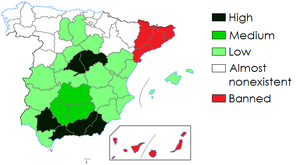
Activism against bullfighting has existed in Spain since the beginning of the early 19th century, when a group of intellectuals, pertaining to the Generation of '98, rallied against the popularity of bullfighting and flamenco music, dismissing them as "non-European" elements of Spanish culture which were to blame for the country's social and economic backwardness.[37][38]
Since in the 20th century, bullfighting has come under increasing attack from animal rights activists and political actors for its links to nationalism.[39] Separatist and nationalist sentiment in Catalonia has played a key role in the region wide ban of a practice which is strongly associated to Spanish national identity. Galician and Basque nationalists have also expressed abolitionist stances, although in the case of the latter this has been somewhat mooted by the conundrum of bullfighting being at the heart of the San Fermin festival in Pamplona. Animal welfare concerns are perhaps the prime driver of opposition to bullfighting outside Spain, although rejection of traditionalism and Criollo elitism may also play a role in Latin America.
Animal rights activists claim bullfighting is a cruel or barbarous blood sport, in which the bull suffers severe stress and a slow, torturous death.[40][41][42] A number of animal rights or animal welfare activist groups such as Antitauromaquia[43] and StopOurShame[44] undertake anti-bullfighting actions in Spain and other countries.
Alexander Fiske-Harrison, "a postgraduate student of both philosophy and biology",[45] who trained as a bullfighter to research for a book on the subject, has argued that there are mitigating circumstances to this:
In terms of animal welfare, the fighting bull lives four to six years whereas the meat cow lives one to two. What is more, it doesn’t just live in the sense of existing, it lives a full and natural life. Those years are spent free, roaming in the dehesa, the lightly wooded natural pastureland which is the residue of the ancient forests of Spain. It is a rural idyll, although with the modern additions of full veterinary care and an absence of predators big enough to threaten evolution’s answer to a main battle tank.
Other arguments include those to the effect that the death of animals in slaughterhouses is often much worse than the death in the ring, and that both types of animal die for entertainment since humans do not need to consume meat, eating it instead for taste (bulls enter the food chain after the bullfight).[46] The last common defense to the practice is the conservationist stance point for both the tradition itself and the Bravo bull variety. Bravo bulls are the closest living relative to the European wild bull, completely extinct now and divided into sub-breeds whose only use is provision of meat, serving the alimentary industry. Without bullfighting and bull spectacles, the last wild bull in Europe is doomed to disappear.
The straightforward supporters question the actual pain the bull may be in, considering the factor of adrenaline, and especially consider how the death of cattle tends to be, and repeat the less than 30 seconds death the animal suffers in the end.
After years of increased pressure against bullfighting by abolitionist movements within Spain, the death of bullfighter Victor Barrio in July 2016 led to hundreds of comments being posted on various social media expressing joy towards the event and openly mocking his family and widow. This led to a significant backlash within Spain against anti-bullfighting activism, and criminal investigations are ongoing against those involved. Within a few days of Barrio's death, over 200,000 signatures had been collecting demanding action be taken against one such activist.[47]
Special events
Professional
- The rejoneo or corrida de rejones: A rejoneador (lancer) on horseback tries to stab the bull with javelins called rejones de castigo in the first stage and banderillas in the second. In the final stage, the rejoneador kills the bull with a rejón de muerte (lance of death). On some occasions, the rejoneador will kill the bull on foot in the traditional way with muleta and estoca.
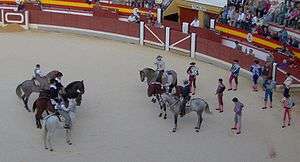 Paseíllo in a corrida de rejones, 2005
Paseíllo in a corrida de rejones, 2005 - The recortes: A bullfighter dodges around the bull and does not use a cape or sword.[48] Bulls are not killed during this type of bullfight. Most specialists in this form of bullfighting come from Aragon.
- Comedy spectacles, such as El bombero torero y los enanitos toreros ("The bullfighting fireman and the bullfighting dwarves").
Amateur
- The encierro: A "running" of the bulls through the streets. Customarily, runners run before the bulls to guide them from the pen to the plaza, where the bulls will await the afternoon's bullfight. The most famous is that of Pamplona in July, although encierros exist in towns throughout Spain. It is a dangerous activity, and care should be taken by those who wish to participate. In Segorbe, bulls are herded to the bullring by riders on horseback, an event called Entrada de toros y caballos, which is a tourist attraction.
- The bous al carrer (bulls at the street in Catalan) commonly found in Comunidad Valenciana and some places in Catalonia. The main difference from a encierro is that the bulls aren't directed to any bullring
- A Mediterranean variation, called bous a la mar (bulls at the sea), takes place on a dock. The youths jump into the water when the cow has cornered them. One place famous for this festivity is Dénia
- Another variation is the toro embolado ("fire bull"). This fiesta takes place at midnight. Balls of flammable material or actual fireworks are placed on the horns. The bull is set free on the street where young men dodge and run away from the charging animal
- The Toro de la Vega: This takes place in September at Tordesillas. A bull is run through an open area and over a bridge across the Duero River. There a crowd (on foot and on horse) tries to kill the bull with spears and lances before it reaches the other side.[49] Considered as an espectáculo tradicional (traditional spectacle) by the government of Castilla y León.
- The vaquillas (sokamuturra in Basque): A young cow of fighting stock is freed in a small ring (often built for the period of the festival and then dismantled) among local youths who tease her. The cow may have a dangling rope for recovery purposes.
Gallery
The phases of the Spanish-style bullfighting
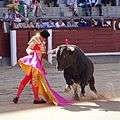 Tercio de varas: Suerte de capote.
Tercio de varas: Suerte de capote. Tercio de varas: El Picador on a caparisoned and blindfolded horse pierces the back of the bull with a spear.
Tercio de varas: El Picador on a caparisoned and blindfolded horse pierces the back of the bull with a spear.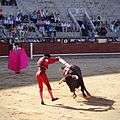 Tercio de banderillas: El Banderillero stabs the banderillas on the back of the bull.
Tercio de banderillas: El Banderillero stabs the banderillas on the back of the bull.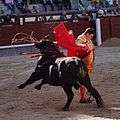 Tercio de muerte: Suerte de muleta.
Tercio de muerte: Suerte de muleta.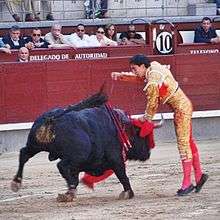 Tercio de muerte: El Matador pierces the heart of the bull with his sword.
Tercio de muerte: El Matador pierces the heart of the bull with his sword.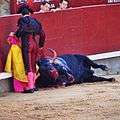 Tercio de muerte: The bull fatally hit falls to the ground.
Tercio de muerte: The bull fatally hit falls to the ground.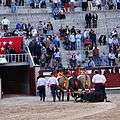 The dead bull is dragged away from the arena.
The dead bull is dragged away from the arena.
See also
- Olé, Olé, Olé
- Portuguese-style bullfighting
- Lamborghini: auto-manufacturer known for naming their cars after Spanish bulls
References
- "Bullfighting - History". Encyclopedia Britannica. Retrieved May 10, 2020.
- Balter, Michael (2016-06-16). The Goddess and the Bull: Çatalhöyük: An Archaeological Journey to the Dawn of Civilization. Routledge. ISBN 978-1-315-41840-7.
- (1999) “Cosmogonía védica del numantino Vaso de Los Toros”, en Revista de Soria nº25, Diputación Provincial de Soria
- Nash, Elizabeth (2005-10-13). Seville, Cordoba, and Granada: A Cultural History. Oxford University Press, USA. ISBN 978-0-19-518204-0.
- LORRIO ALVARADO, A. y OLIVARES PEDREÑO, J.C. (2004): “Imagen y simbolismo del toro en la Hispania céltica”, en Revista de Estudios Taurinos n.º 18, Sevilla
- Schulz, Andrew (2008). "Moors and the Bullfight: History and National Identity in Goya's "Tauromaquia"". The Art Bulletin. 90 (2): 195–217. doi:10.1080/00043079.2008.10786390. ISSN 0004-3079. JSTOR 20619602.
- "A papal bull against bullfighting | Lillian Goldman Law Library". library.law.yale.edu. Retrieved 2020-05-16.
- EXCOMUNIÓN A PERPETUIDAD San Pío V: Bula «DE SALUTIS GREGIS DOMINICI» (1567) «Bullarum Diplomatum et Privilegiorum Sanctorum Romanorum Pontificum Taurinensis editio», Vol VII, Augustae Taurinorum 1862, pages 630-631
- "The end of bullfighting?". theweek.com. 2010-08-06. Retrieved 2020-05-16.
- Cowans, Jon (2003-05-12). Early Modern Spain: A Documentary History. University of Pennsylvania Press. ISBN 978-0-8122-1845-9.
- Harbour, Berna González (2017-09-12). "The day will come when bullfighting is history". EL PAÍS. Retrieved 2020-05-25.
- "Joaquín Rodríguez Costillares | Spanish bullfighter". Encyclopedia Britannica. Retrieved 2020-05-24.
- A, Reza Hosseinpour (2014-07-09). Making sense of bullfighting. Punto Rojo Libros. ISBN 978-1-62934-784-4.
- "Cuadrilla | bullfighting". Encyclopedia Britannica. Retrieved 2020-05-24.
- A, Reza Hosseinpour (2014-07-09). Making sense of bullfighting. Punto Rojo Libros. ISBN 978-1-62934-784-4.
- Nauright, John; Parrish, Charles (2012). Sports Around the World: History, Culture, and Practice. ABC-CLIO. ISBN 978-1-59884-300-2.
- Landborn, Adair (2015-09-18). Flamenco and Bullfighting: Movement, Passion and Risk in Two Spanish Traditions. McFarland. ISBN 978-1-4766-1957-6.
- Cassidy, Kenneth (April 13, 2012). "Bullfighting in Spain – Music In The World". Retrieved May 10, 2020.
- Condra, Jill (2013-04-09). Encyclopedia of National Dress: Traditional Clothing around the World [2 volumes]. ABC-CLIO. ISBN 978-0-313-37637-5.
- Pedraza, Felipe (2005) [1998]. Iniciación a la fiesta de los toros # 4.4 El traje de torear (in Spanish). Biblioteca Edaf. ISBN 978-84-414-0293-5.
- Hemer, Susan R.; Dundon, Alison (2016-09-15). Emotions, Senses, Spaces:: Ethnographic Engagements and Intersections. University of Adelaide Press. ISBN 978-1-925261-27-1.
- "Bull-fighting glossary - Office de tourisme d'Arles - France". www.arlestourisme.com. Retrieved 2020-06-10.
- "Tercio de varas". TheFreeDictionary.com. Retrieved 2020-05-28.
- "Veronica | bullfighting". Encyclopedia Britannica. Retrieved 2020-06-27.
- A, Reza Hosseinpour (2014-07-09). Making sense of bullfighting. Punto Rojo Libros. ISBN 978-1-62934-784-4.
- A, Reza Hosseinpour (2014-07-09). Making sense of bullfighting. Punto Rojo Libros. ISBN 978-1-62934-784-4.
- A, Reza Hosseinpour (2014-07-09). Making sense of bullfighting. Punto Rojo Libros. ISBN 978-1-62934-784-4.
- A, Reza Hosseinpour (2014-07-09). Making sense of bullfighting. Punto Rojo Libros. ISBN 978-1-62934-784-4.
- "Tercio de banderillas". Encyclopedia Britannica. Retrieved 2020-06-30.
- Marvin, Garry (1994). Bullfight. University of Illinois Press. ISBN 978-0-252-06437-1.
- "Why Do Bulls Charge When they See Red?". livescience.com.
- Matthews, Dylan (2016-07-05). "Watch what really happens after the Running of the Bulls". Vox. Retrieved 2020-07-03.
- "This 26-Year-Old Matador Is Bullfighting's Last Great Hope". Sharp Magazine. Retrieved 2020-07-03.
- Lorca, Antonio (2016-12-06). "Los toros son el décimo espectáculo de masas de España (y no el segundo)". EL PAÍS (in Spanish). Retrieved 2017-09-06.
- Haynes |, Rachel (2018-08-10). "10 August 1974: Spain lifts ban on women bullfighters". surinenglish.com. Retrieved 2020-05-27.
- "Spain's Female Bullfighters Fight Men, Too". The New York Times. 1983-10-02. ISSN 0362-4331. Retrieved 2020-05-27.
- Goodman, Al (1998-01-01). "Arts Abroad; Maybe Spain's 1898 Defeat Was No Great Loss After All". The New York Times. ISSN 0362-4331. Retrieved 2020-05-27.
- Gasman, Lydia (2007). War and the Cosmos in Picasso's Texts, 1936-1940. Universe. ISBN 978-0-595-39900-0.
- Brandes, Stanley. "Torophies and Torphobes: The Politics of Bulls and Bullfights in Contemporary Spain" (PDF). University of California, Berkeley.
- "Bullfighting". League Against Cruel Sports. Retrieved 2017-09-06.
- "ICABS calls on Vodafone to drop bullfighting from ad". www.banbloodsports.com. Retrieved 2017-09-06.
- The suffering of bullfighting bulls, CAS International, archived from the original on 2009-01-26
- GerardRodriguez.es. "Antitauromaquia.es – Principal". www.antitauromaquia.es. Retrieved 2017-09-06.
- "SOS | Stop Our Shame". www.stopourshame.com. Retrieved 2017-09-06.
- France, Miranda, "'Blood, Sweat and Tears: Into the Arena: The World of the Spanish Bullfight", Literary Review, 389, July 2011
- Fiske-Harrison, Alexander, "Perhaps bullfighting is not a moral wrong: My talk at the Edinburgh International Book Festival", The Last Arena: In Search Of The Spanish Bullfight blog. 25 July 2012
- "Más de 217.000 firmas piden la inhabilitación del 'professor' que insultó al torero fallecido Víctor Barrio—Segoviadirecto.com Diario Digital de Segovia". Segoviadirecto.com Diario Digital de Segovia (in Spanish). Retrieved 2017-09-06.
- "a man jumps over a bull during a recortadores bullfight in Algeciras, Spain". The Sydney Morning Herald.
- Douglass, Carrie B. (1997). Bulls, Bullfighting, And Spanish Identities. ISBN 0-8165-1651-0.